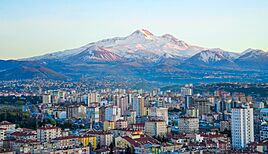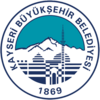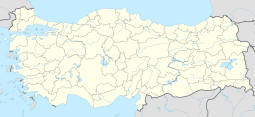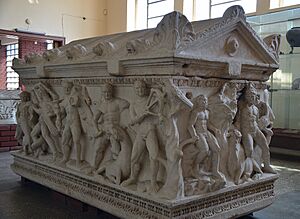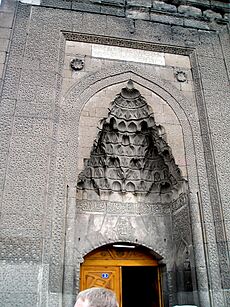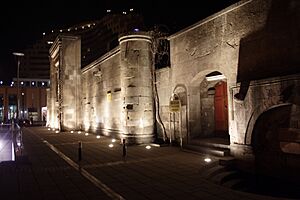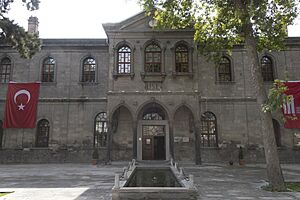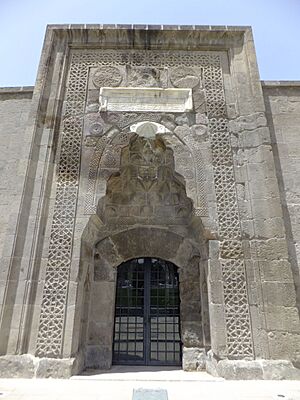Kayseri facts for kids
Quick facts for kids
Kayseri
|
||
|---|---|---|
|
Metropolitan municipality
|
||
|
Clockwise from top: Mount Erciyes, Bürüngüz Mosque in Cumhuriyet Square, Sivas Street, Hunat Hatun Complex, Kayseri Castle, Kayseri Tram, Kadir Has Stadium
|
||
|
||
| Country | Turkey | |
| Region | Central Anatolia | |
| Province | Kayseri | |
| Area | ||
| • Metropolitan municipality | 17,043 km2 (6,580 sq mi) | |
| • Urban | 3,620 km2 (1,400 sq mi) | |
| • Metro | 2,810 km2 (1,080 sq mi) | |
| Elevation | 1,050 m (3,440 ft) | |
| Population
(31 December 2021 estimate)
|
||
| • Metropolitan municipality | 1,434,357 | |
| • Density | 84.1611/km2 (217.976/sq mi) | |
| • Urban | 1,204,641 | |
| • Urban density | 332.8/km2 (861.9/sq mi) | |
| • Metro | 1,175,886 | |
| • Metro density | 418.5/km2 (1,083.8/sq mi) | |
| GDP | ||
| • Metropolitan municipality | TRY 107.378 billion US$ 11.956 billion (2021) |
|
| • Per capita | TRY 75,200 US$ 8,373 (2021) |
|
| Time zone | UTC+3 (TRT) | |
| Postal code |
38x xx
|
|
| Area code(s) | (+90) 352 | |
| Licence plate | 38 | |
Kayseri is a large city in Central Anatolia, Turkey. It is the capital of Kayseri province. Long ago, it was known as Caesarea. It has been the main city of Cappadocia for a very long time.
The Kayseri Metropolitan Municipality area includes five districts. These are Kocasinan and Melikgazi, which are central. Since 2004, it also includes Hacılar, İncesu, and Talas.
As of 2021, the province had over 1.4 million people. Most of them, about 1.1 million, live in the main urban areas.
Kayseri is located at the base of Mount Erciyes. This is a volcano that is not active right now. It stands very tall, reaching over 3,900 meters high. This is more than 1,500 meters above the city itself. Kayseri has many old buildings, especially from the Seljuk period. Many tourists visit Kayseri on their way to the famous Cappadocia region.
The city has its own airport, Erkilet International Airport. It is also home to Erciyes University.
Contents
What's in a Name?
Kayseri was first called Mazaca or Mazaca. The ancient Greek geographer Strabo knew it by this name. At that time, it was the capital of the Roman province of Cappadocia. It was also known as Eusebia at the Argaeus. This name honored King Ariarathes V Eusebes.
In 14 AD, its name was changed to "Caesarea in Cappadocia". This was done to honor Caesar Augustus after he passed away. The name Caesarea was pronounced Kaisáreia in Greek. When the first Turks arrived in the area around 1080 AD, they used a similar sound. This eventually became Kayseri in Turkish, which is still its name today.
A Look Back in Time
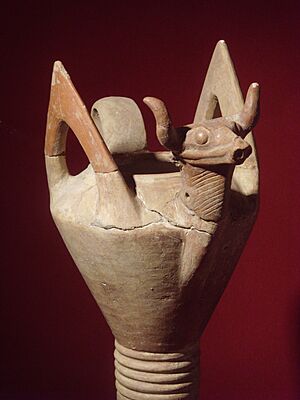
Kayseri has had three important periods of growth and success. The first was around 2000 BC. At this time, the city was a busy trading spot between the Assyrians and the Hittites.
The second important time was under Roman rule, from the 1st to the 11th centuries. The third golden age happened during the Seljuk rule, from 1178 to 1243. During this time, Kayseri was the second capital of the Seljuk Sultanate of Rum. The Seljuk period was not very long, but it left many important historical buildings. These include the Hunat Hatun Complex, the Kiliç Arslan Mosque, the Ulu Camii (Grand Mosque), and the Gevher Nesibe Hospital.
Ancient Times
As Mazaca, the city was where the kings of Cappadocia lived. In ancient times, it was a key point on trade routes. These routes connected places like Sinope to the Euphrates River. Another important route, the Persian Royal Road, also passed through the city.
St Basil, a famous religious leader, built a large complex in Caesarea Mazaca in the 4th century. Sadly, nothing of it remains today. The city was built on a low hill on the north side of Mount Erciyes. Very few signs of the ancient city are left.
Islamic Era
In 647, the Arab general Muawiyah took Caesarea from the Byzantines for a short time. The Arabs called the city Kaisariyah. Later, the Seljuk Turks captured it in 1067 and called it Kayseri. After this, the city was empty for about 50 years.
From 1074 to 1178, the Danishmendids controlled the area. They rebuilt the city in 1134. The Anatolian Seljuk Sultanate then ruled from 1178 to 1243. Kayseri was one of their most important cities until the Mongols took it in 1243. The city was rebuilt again between the 13th and 16th centuries. Later, it became part of the Ottoman Empire in 1515.
Modern Times
The Grand Bazaar in Kayseri was built in the late 1800s. The nearby caravanserai, a place for traders, is even older, from around 1500. Sadly, many of the city's old, beautiful mansion-houses were torn down starting in the 1970s.
During the Turkish War of Independence, the Kayseri Lyceum building was used for the Turkish Grand National Assembly. This happened when the Greek army was moving towards Ankara.
Geography and Weather
Climate
Kayseri has a continental climate. This means it has cold, snowy winters. Summers are hot and dry, but the nights are cool. It rains throughout the year, but less in late summer and early fall.
| Climate data for Kayseri (1991–2020, extremes 1931–2021) | |||||||||||||
|---|---|---|---|---|---|---|---|---|---|---|---|---|---|
| Month | Jan | Feb | Mar | Apr | May | Jun | Jul | Aug | Sep | Oct | Nov | Dec | Year |
| Record high °C (°F) | 19.3 (66.7) |
22.6 (72.7) |
28.6 (83.5) |
31.2 (88.2) |
34.2 (93.6) |
37.6 (99.7) |
40.7 (105.3) |
40.6 (105.1) |
38.4 (101.1) |
33.6 (92.5) |
26.0 (78.8) |
21.0 (69.8) |
40.7 (105.3) |
| Mean daily maximum °C (°F) | 4.6 (40.3) |
6.6 (43.9) |
12.2 (54.0) |
17.9 (64.2) |
22.7 (72.9) |
27.4 (81.3) |
31.3 (88.3) |
31.4 (88.5) |
27.1 (80.8) |
20.8 (69.4) |
12.9 (55.2) |
6.5 (43.7) |
18.4 (65.1) |
| Daily mean °C (°F) | −1.0 (30.2) |
0.5 (32.9) |
5.6 (42.1) |
10.7 (51.3) |
15.1 (59.2) |
19.3 (66.7) |
22.7 (72.9) |
22.6 (72.7) |
18.0 (64.4) |
12.4 (54.3) |
5.4 (41.7) |
0.8 (33.4) |
11.0 (51.8) |
| Mean daily minimum °C (°F) | −5.4 (22.3) |
−4.5 (23.9) |
−0.1 (31.8) |
3.9 (39.0) |
7.6 (45.7) |
11.0 (51.8) |
13.5 (56.3) |
13.3 (55.9) |
9.0 (48.2) |
4.9 (40.8) |
−0.5 (31.1) |
−3.6 (25.5) |
4.1 (39.4) |
| Record low °C (°F) | −32.5 (−26.5) |
−31.2 (−24.2) |
−28.1 (−18.6) |
−11.6 (11.1) |
−6.9 (19.6) |
−0.6 (30.9) |
2.9 (37.2) |
1.4 (34.5) |
−3.8 (25.2) |
−12.2 (10.0) |
−20.7 (−5.3) |
−28.4 (−19.1) |
−32.5 (−26.5) |
| Average precipitation mm (inches) | 38.0 (1.50) |
38.9 (1.53) |
49.6 (1.95) |
46.9 (1.85) |
57.9 (2.28) |
40.6 (1.60) |
11.9 (0.47) |
9.5 (0.37) |
14.0 (0.55) |
32.3 (1.27) |
29.3 (1.15) |
39.3 (1.55) |
408.2 (16.07) |
| Average precipitation days | 11.4 | 11.0 | 13.1 | 13.6 | 13.5 | 9.7 | 2.3 | 2.2 | 4.5 | 7.1 | 7.8 | 10.2 | 106.4 |
| Average relative humidity (%) | 75.9 | 71.5 | 64.3 | 58.9 | 58.9 | 54.5 | 46.6 | 46.7 | 50.5 | 61.6 | 68.1 | 75.3 | 61.0 |
| Mean monthly sunshine hours | 89.9 | 113.0 | 145.7 | 183.0 | 248.0 | 300.0 | 356.5 | 341.0 | 255.0 | 195.3 | 141.0 | 83.7 | 2,452.1 |
| Mean daily sunshine hours | 2.9 | 4.0 | 4.7 | 6.1 | 8.0 | 10.0 | 11.5 | 11.0 | 8.5 | 6.3 | 4.7 | 2.7 | 6.7 |
| Source 1: Turkish State Meteorological Service | |||||||||||||
| Source 2: NOAA (humidity, 1991–2020) | |||||||||||||
People of Kayseri
In 1914, about 18,907 Armenians lived in Kayseri. This was about 35% of the city's population. Later, many people from different backgrounds moved from the city or were relocated. This included Armenian and Greek Orthodox residents.
Fun Places to Visit
In Kayseri City
- Republic Square
- Kayseri Castle
- Kayseri Clock Tower
- Bürüngüz Mosque
- Hunat Mosque
- Kayseri Bazaar (Kapali Carsi)
- Forum Kayseri
- Surp Asdvadzadzin Virgin Mary Church Research Library
- Atatürk House Museum
- The National Struggle Museum
The most striking reminder of the past in Kayseri are the huge basalt walls. These walls once surrounded the old city. They date back to the sixth century. They have been repaired many times over the centuries. In 2019, the Kayseri Archaeology Museum moved inside these walls.
The Grand Mosque (Ulu Cami) was started by the Danişmend emir Melik Mehmed Gazi. It was finished by the Seljuks after his death.
There are many amazing buildings from the Seljuk period. These include many smaller kümbets (domed tombs). The most impressive is the Döner Kümbet (Revolving Tomb). The oldest Seljuk mosque still standing is the Hunat Hatun Mosque complex. It has a working Turkish bath that dates back to 1238.
Near the mosque is the Sahabiye Medresesi. This was a religious school built in 1267. It has a beautiful entrance typical of Seljuk buildings. The Avgunlu (Havuzlu) Medresesi is very similar. It is now a large bookshop and cafe in a park.
In Mimar Sinan Park, you'll find the Çifte Medresesi. These are two Seljuk-era religious schools. They were later used as a hospital for people with mental health issues. Today, these buildings house the Museum of Seljuk Civilisations.
Another Seljuk building is the grand Halikılıç Mosque. It has two amazing entrance doors. It was built in 1249 and restored later.
The Güpgüpoğlu Mansion is from after the Seljuk period. It dates back to the early 15th century. You can visit it to see how it looked in the late 1800s.
Close to the walls is Kayseri's own Kapalı Çarşı (Covered Market). It is still a busy place selling clothes, shoes, and many other things. Inside is the older and very cool Vezir Han. This building was made in the early 1700s.
Around Kayseri
The Kayseri suburb of Talas was the home of famous people like Calouste Gulbenkian. Many of its old buildings were rebuilt in the early 2000s. The Greek Orthodox Church of St Mary, built in 1888, is now a mosque. The suburb of Germir also has old houses and churches.
Mount Erciyes (Erciyes Dağı) stands tall over Kayseri. It is a great place for trekking and alpinism. In recent years, a small ski resort there has grown into a big international attraction. It now has large hotels and facilities for all kinds of winter sports.
The ancient site of Kanesh-Kültepe is 20 km northeast of Kayseri. It is one of the oldest cities in Asia Minor.
Ağırnas, a small town with many lovely old houses, was the birthplace of the great Ottoman architect Mimar Sinan. A house believed to be his is now a museum. Below it, there is an 'underground city,' common in Cappadocia.
The small town of Develi also has some nice old houses. An old Armenian Church there is now a mosque.
Economy and Business
Kayseri received a lot of government money for development in the 1920s and 1930s. Factories like Sumer Textiles and Kayseri Tayyare Fabrikasi (an airplane maker) were built. The airplane factory even made the first aircraft "made in Turkey" in the 1940s.
After the 1950s, government investment slowed down. However, business people from Kayseri started to invest their own money. Families like Sabancı and Dedeman began as small merchants in Kayseri. They later became very important in the Turkish economy. Even if they moved their main offices to other cities, they often came back to Kayseri to invest.
Thanks to new economic policies in the 1980s, many new businesses started in Kayseri. Most of these new companies chose Kayseri as their main base. Because of better facilities, the city has grown a lot since 2000. It is now known as one of Turkey's "Anatolian Tigers" for its fast economic growth.
The city grew so quickly that in 2004, it applied to the Guinness Book of World Records. It wanted to be recognized for starting 139 new factories in a single day! Kayseri is also a very successful place for making furniture. It earned over a billion dollars from furniture exports in 2007. The city is especially good for small and medium enterprises.
The Kayseri Free Zone was set up in 1998. It has over 43 companies and a large investment. This zone helps with production, trading, storage, and many other business activities. Kayseri FTZ is one of the most affordable free zones in the world.
Some experts believe Kayseri's economic success comes from a modern Islamic way of thinking. They call it "Islamic Calvinism."
Getting Around
The city has Erkilet International Airport (ASR). It is close to the city center and has many flights to Istanbul every day.
Kayseri is connected to other parts of Turkey by trains. There are four trains a day to Ankara. To the east, trains go to Kars and Tatvan.
Since Kayseri is in central Turkey, road travel is very good. It takes about three hours to reach Ankara. It also takes about three hours to get to the Mediterranean coast. You can reach Cappadocia in just 45 minutes. Mount Erciyes is a great place for skiing in winter and hiking in summer. It is only 30 minutes from the city center.
Within the city, people mostly use buses and cars. There is also a light rail transit (LRT) system called Kayseray. It connects to the inter-city bus station and to Talas.
Sports in Kayseri
Kayseri has a professional football team, Kayserispor. They play in Turkey's top league. In 2006, Kayserispor was the only Turkish team to win the UEFA Intertoto Cup.
The Erciyes Ski Resort on Mount Erciyes is one of the biggest ski resorts in Turkey.
The women's football club Kayseri Gençler Birliği was promoted to the top women's league in 2020.
Sports Venues
- Kadir Has Stadium is a modern stadium built in 2009. It can hold 33,000 fans and is fully covered. Both Kayseri football clubs use this stadium. The stadium is connected by the Kayseray light-rail system. It hosted the opening ceremony and first match of the 2013 FIFA U-20 World Cup.
- Kadir Has Sports Arena is an indoor arena that opened in 2008. It can seat 7,200 people. It is part of the Kayseri Kadir Has Sports Complex. This complex is one of Turkey's most modern sports centers. It was also a venue for the 2010 FIBA World Championship in basketball.
Education
Kayseri High School (Kayseri Lisesi) was founded in 1893. It is one of Turkey's oldest high schools. Küçükçalık Anatolian High School teaches in English. TED Kayseri College is a private school that has been open since 1966.
Kayseri has three state universities and one private university:
- Abdullah Gül University is a state university that started in 2013.
- Erciyes University is the city's largest research university. It has a long history, with roots back to 1206. Today, it has many departments and over 41,000 students.
- Nuh Naci Yazgan University is a private university founded in 2009.
- Kayseri University
Delicious Food
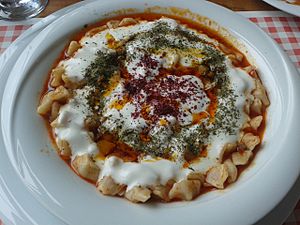
Kayseri is famous for its special foods. These include mantı (a type of dumpling), pastırma (cured beef), and sucuk (a spicy sausage). Another special dish is stuffed zucchini flowers. For dessert, try Nevzine.
Notable People from Kayseri
- Nuri Demirağ (1883–1957), a businessman and politician.
- Hasan Kaçan (1957–), an actor and cartoonist.
- Hulusi Akar (1952–), a soldier and politician. He was a former Minister of National Defense.
- Şule Yüksel Şenler (1938–2019), an Islamic writer and activist.
- Hacı Ömer Sabancı (1906–1966), a businessperson who founded Sabancı Holding.
- Berna Gözbaşı (1974–), the president of Kayserispor.
- Sakıp Sabancı (1933–2004), a famous businessman and former CEO of Sabancı Holding.
- Güler Sabancı (1955–), a businesswoman and current CEO of Sabancı Holding.
- Kadir Has (1931–2007), a businessman.
- Alparslan Türkeş (1917–1997), a soldier and politician.
- Abdullah Gül (1950–), the 11th President of Turkey.
Kayseri Mayors
- 1984–1989: Hüsamettin Çetinbulut
- 1989–1994: Niyazi Bahçecioğlu
- 1994–1998: Şükrü Karatepe
- 1998–2015: Mehmet Özhaseki
- 2015–present: Mehmduh Büyükkkılıç
Sister Cities
Kayseri has "sister city" relationships with these places:
Images for kids
See also
 In Spanish: Kayseri para niños
In Spanish: Kayseri para niños


